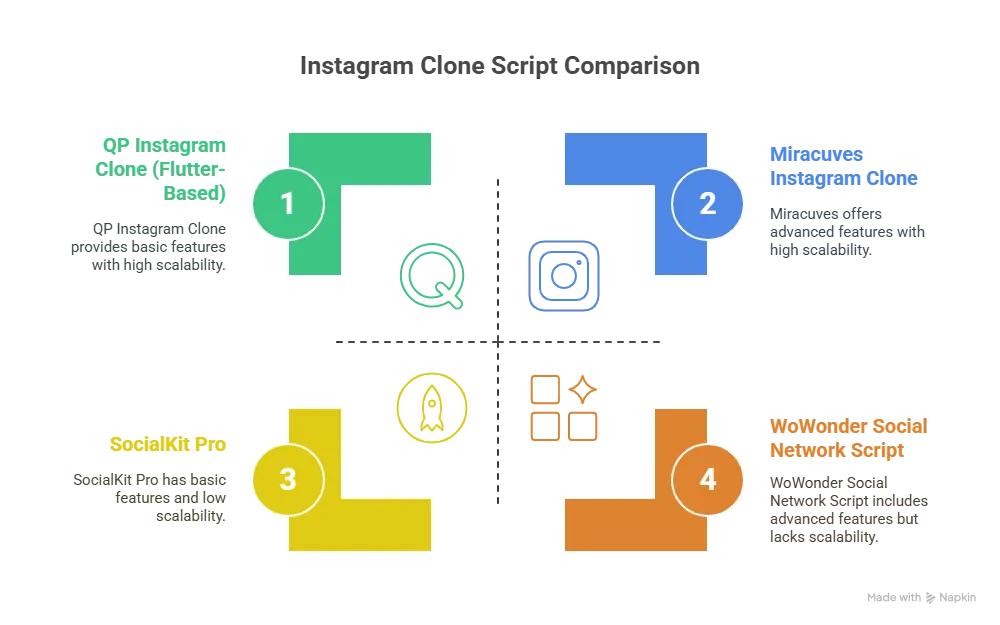There’s something magnetic about photos, reels, and 15-second bursts of viral glory. Instagram tapped into that magic and turned it into a cultural phenomenon. Fast-forward to 2025, and the hunger for visually-driven social platforms hasn’t slowed down — it’s evolved. From niche communities to influencer-first networks, creators and founders alike are rushing to build their own Instagram-style platforms.
Whether you’re targeting fashion lovers, pet parents, artists, or fitness buffs, launching a photo-sharing app has never been more feasible. You don’t need a hundred engineers and a Silicon Valley zip code. With a solid Instagram clone script, you can skip the painful groundwork and get straight to launching a feature-packed social platform.
In this blog, we’ll explore the best Instagram clone scripts available in 2025, what features they offer, how much they cost, and what to keep in mind as you build your social media empire.
Why Launch an Instagram Clone in 2025?
Content is the New Currency
In today’s creator economy, attention is money. Whether it’s micro-influencers promoting products or everyday users sharing life updates, everyone wants a space to express themselves visually — and many are tired of being at the mercy of algorithm changes on big platforms.
Niche Social Networks Are Thriving
Generalist platforms like Instagram and TikTok still dominate, but niche communities are booming. Think apps just for dancers, makeup artists, or book lovers. These smaller platforms drive stronger engagement and trust — especially when built around identity and belonging.
Ad Revenue & Subscriptions Are Proven Models
Monetization isn’t a guessing game anymore. From in-app ads and sponsored posts to paid subscriptions and virtual gifts, social platforms now have multiple proven paths to profitability.
Read More : Reasons startup choose our Instagram clone over custom development
What Should You Look For in an Instagram Clone Script?
Launching a social photo app isn’t just about letting users post pretty pictures. Today’s users want full control over their content, identity, engagement, and monetization. A modern Instagram clone should include:
User-Facing Features
- Account creation with profile customization
- Photo and video upload with editing tools
- Hashtags, tags, mentions, and geotagging
- Reels, stories, or short-form video support
- Real-time likes, comments, and shares
- Follow/unfollow and suggested users
- Notifications and activity feed
Admin Panel
- User management and content moderation
- Post analytics and user reports
- Ads and promotions configuration
- Role-based access for moderators and admins
- CMS for privacy policy, terms, and FAQs
Monetization Options
- Ad module for banners or sponsored posts
- Creator tipping or donation features
- Premium account upgrades
- Subscription content (locked posts, exclusive reels)
Other essentials include data privacy compliance, mobile responsiveness, and scalable backend infrastructure.
Best Instagram Clone Scripts in 2025

1. Miracuves Instagram Clone
Overview: Built for founders and creators who want to launch fast and scale big. This clone script offers a sleek, intuitive UI along with full backend control and monetization features.
Key Features:
- Post, story, and reel sharing
- Content discovery via explore tab
- Live streaming support
- Real-time chat and notifications
- Multi-language interface
Best For: Startups, creator platforms, and community-based social apps
Pros: Scalable architecture, highly customizable, monetization-ready
Cons: Requires clear community guidelines and initial content seeding
2. SocialKit Pro
Overview: A PHP-based Instagram-style app with a responsive web interface. Good for bootstrappers and basic MVPs.
Key Features:
- Photo sharing and comment system
- Follow/unfollow logic
- Direct messaging
Best For: Solo founders or first-time social app builders
Pros: Lightweight and easy to install
Cons: No short-form video, limited moderation tools
3. WoWonder Social Network Script
Overview: A feature-rich social platform builder that includes Facebook and Instagram-like modules.
Key Features:
- Timeline feed and media uploads
- Pages and groups feature
- Ad manager for site monetization
Best For: Founders seeking hybrid social functionality (photo + microblog)
Pros: Feature-heavy, multi-device support
Cons: Can feel bloated for pure Instagram-style apps
4. QP Instagram Clone (Flutter-Based)
Overview: Built in Flutter for native mobile performance on iOS and Android, with Firebase backend.
Key Features:
- Real-time post feed
- Story and short-form video support
- Firebase cloud messaging
Best For: Mobile-first platforms targeting Gen Z and creator communities
Pros: Smooth mobile UX, scalable with Firebase
Cons: Requires setup for advanced features like subscriptions or ads
Cost Factors & Pricing Breakdown
Instagram-Like Social Media Platform Development — Market Price
| Development Level | Inclusions | Estimated Market Price (USD) |
|---|---|---|
| 1. Basic Social Media MVP | User signup/login, profile creation, photo posting, basic feed, likes & comments, follow system, and a simple admin panel. | $60,000 |
| 2. Mid-Level Photo & Video Platform | Web + mobile UI/UX, stories, reels/short videos, hashtags, explore feed, notifications, DMs, content moderation, and analytics. | $140,000 |
| 3. Advanced Instagram-Level Platform | Algorithmic feed, live streaming, creator tools, ads & promotions, verification badges, subscriptions, AI moderation, and enterprise-grade scalability. | $300,000+ |
These figures represent typical global development costs for building a feature-rich, real-time social networking platform like Instagram — including media handling, discovery algorithms, and creator monetization.
Miracuves Pricing for an Instagram-Like Platform
Miracuves Price: Starts at $3,299
This includes a complete social media ecosystem with user profiles, photo & video feeds, stories, engagement tools, messaging, notifications, content moderation, and a powerful admin backend — fully customizable and ready to launch under your brand.
Note:
Includes full non-encrypted source code, backend setup, admin configuration, UI integration, API connections, and deployment assistance — enabling you to operate an Instagram-style social platform with full ownership and scalability.
Launch Your Instagram-Style Social Media Platform — Contact Us Today
Delivery Timeline for an Instagram-Like Platform with Miracuves
A typical delivery timeline is 3–9 days, depending on:
- Media types enabled (photos, videos, reels, live)
- Feed logic (chronological vs algorithmic)
- Messaging & notification depth
- Branding & UI/UX customization
- Moderation & safety features
- Monetization or ads-module integrations
Tech Stack
Built using a PHP & JS hybrid architecture, optimized for real-time feeds, high-volume media delivery, scalable user interactions, and modular expansion for modern social networking platforms.
Monetization Models That Work
The business side of social media apps has evolved beyond basic ad revenue. Here are models that work in 2025:
1. In-App Ads
Offer sponsored posts or native banner placements. Use programmatic ad networks or build your own ad engine.
2. Subscription Tiers
Give users the option to upgrade to a premium plan for ad-free experience, analytics, or creator tools.
3. Virtual Gifting
Let followers tip their favorite creators with virtual coins, stickers, or tokens that convert to real currency.
4. Branded Content Marketplace
Facilitate brand-creator collaborations by charging a matchmaking fee or taking a cut of the deal.
5. Paid Content Access
Creators can lock certain stories, reels, or posts behind a paywall — ideal for influencers, artists, or fitness coaches
Read More : Top 10 Ideas for Social Media Influencer Marketing Business Startups.
Pitfalls to Avoid When Building a Photo Sharing App
It’s easy to get caught up in the buzz, but there are traps waiting for founders who don’t plan ahead.
- Lack of a Unique Angle: Don’t build “just another Instagram.” Find your niche — whether it’s a demographic, theme, or feature.
- Weak Content Seeding: An empty feed is a ghost town. Seed early with quality content, influencers, or test users.
- Ignoring Moderation: User-generated content means spam, nudity, and abuse are real risks. Build in filters, reports, and moderation tools from day one.
- No Monetization Strategy: If you’re relying purely on ads, you’ll struggle. Plan multiple revenue streams.
- Overbuilding Early: Launch with core features. Reels, filters, and live features can come later if needed.
Conclusion
The market for visually-driven social apps isn’t slowing down — it’s diversifying. With the right Instagram clone script, you can tap into niche audiences, empower creators, and launch a platform that’s fast, beautiful, and scalable. The key is picking the right foundation, understanding your audience, and building community with purpose.
At Miracuves, we help innovators launch high-performance app clones that are fast, scalable, and monetization-ready. Ready to turn your idea into reality? Let’s build together.
FAQs
Still have questions about launching an Instagram-style platform? Let’s clear them up.
Can I use clone scripts to build a niche-only social app?
Yes. You can customize features, branding, and even the posting experience to serve niche markets — like pet lovers, artists, or travelers.
Are short-form videos included in these scripts?
Many scripts now include reels or TikTok-style videos as standard. Others offer them as paid add-ons or via third-party integrations.
How do I moderate content?
Most scripts come with basic moderation tools, but for serious growth, consider adding AI-based filters, community reporting, and manual review tools.
Is there support for in-app purchases?
Yes. Top-tier clone scripts include payment gateway integrations for tipping, subscriptions, and marketplace features.
Can I start with just mobile or do I need web too?
You can launch mobile-only if your audience skews younger. However, a web presence helps with discoverability and SEO.
How long does it take to launch?
With a ready-made script, your MVP can be live in 3-9 days , depending on the level of customization and testing required.
Related Articles
- How to Market a Social Networking and Community Platform Successfully After Launch
- Best Facebook Clone Scripts in 2025: Features & Pricing Compared
- Best Threads Clone Scripts in 2025: Features & Pricing Compared
- Best Twitter Clone Scripts in 2025: Features & Pricing Compared
- How to Develop a Social Networking and Community Platform








